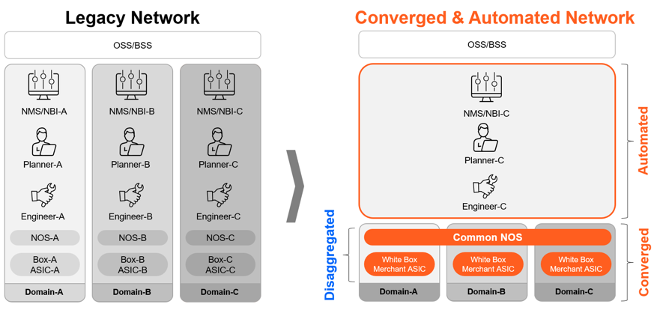Time to change: Service providers should reinvent their networks
Recent advancements like network disaggregation, ZR+ long-distance optics, and converged transport (L1) & IP (L3) enable the creation of a software-centric, optimized network with a unified automation system that simplifies operations across the entire network.
Fragmented network topologies and operational models
Current network topologies and operation models are fragmented and complex. Organizations rely on multiple vendors, tens of platform types, and hundreds of components. This diverse ecosystem – including aging hardware equipment and thousands of software versions, each with distinct data models, bugs, and security patches – requires constant management.
The support infrastructure also is fragmented, requiring dedicated teams for design, lab operations, IT, and development. In addition, the operating model is heavily manual, relying on command-line interfaces (CLIs), third-party tools, and various manual interfaces between systems. All these increase the risk of human error and hamper efficiency and scalability, creating challenges for network management and optimization.
What is needed to transform networks
The solution is to build a new network designed to consolidate the subnetworks and optical networks, transforming it to become as efficient and scalable as hyperscaler networks. To achieve this outcome, it is imperative to turn the legacy network into a converged, software-centric network, while enabling the introduction of automation and artificial intelligence for IT operations (AIOps) at a massive scale.
A converged and automated network aims to change the SP cost structure by collapsing and converging network layers, reducing the number of sites needed to operate the network, and lowering overall hardware footprint and power consumption. This approach streamlines network configuration and provisioning while increasing reliability by eliminating manual processes.
Key architecture concepts for transforming networks
 Transforming the network requires addressing the following key architecture concepts:
Transforming the network requires addressing the following key architecture concepts:
- Disaggregation: Disaggregation, which empowers cloud-like architecture, enables SPs to manage hardware and software independently. Consequently, SPs can mix and match HW and SW from multiple vendors to increase cost savings through supply chain diversity.
- Convergence: Converged network methodology is derived from the hyperscale network architecture playbook, which demonstrates how to develop, build, scale, and maintain network and cloud infrastructure. This includes shared resources, simplified topology, identical and small building blocks, and a small blast radius, among other principles.
- Automation: Like convergence, the methodology for building automation platforms is derived from hyperscale network architecture. This includes DevOps tools, microservices with Docker containers, a unified data model, end-to-end lifecycle automation, and no maintenance windows (24/7×365), among others.
What can be achieved from network transformation?
The following benefits can be achieved by implementing network transformation:
- Improved cost structure (reduced OpEx)
- Collapsing network layers, reducing hardware footage and power usage
- Reducing the number of sites / data centers needed to operate the network
- Future operational simplification with AI-driven automation tools
- Enhanced network resilience and security
- Consolidating network layers for increased reliability and reduced outages
- Eliminating manual processes
- Automating fault detection and resolution
- Top-line growth
- Enabling rapid new service introduction and revenue generation due to software-based networks
- Leverage SPs’ real-time customer data and network telemetry for service personalization and customer retention.
Why is DriveNets the solution for network transformation?
DriveNets Network Cloud is the only solution that enables building networks like hyperscalers: converged, open, and software-based. Unlike incumbent network vendors that are cutting investments and inhibiting innovation in the SP market, DriveNets stands out as a leader in disaggregation.
DriveNets offers an open, software-based, converged, and automated solution, backed by extensive experience with the largest networks in the world and successful projects with tier-1 operators. Through software innovation, DriveNets provides a unified hardware and software platform using a common network operating system (NOS) across the entire network.
Download white paper
Disaggregated Converged Networks-Next-Gen Optics Interfaces




